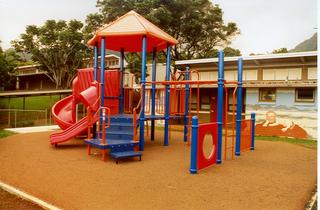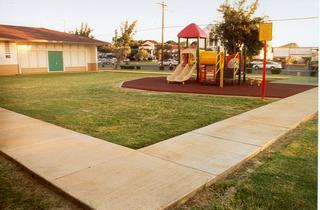Honolulu Advertiser, January 23, 2008
By: Eloise Aguiar
Playground equipment installed at dozens of public parks less than 10 years ago is deteriorating due to rust, corrosion and wear, and the lack of a comprehensive city maintenance program has left many of the structures with holes or broken pieces that residents say pose a safety hazard and can take months to repair.
Conditions at a small community park on Peterson Lane in Kalihi are typical of what parents and Honolulu's youngest citizens have to deal with at many parks.
A ladder is missing from the play structure, the soft flooring used to prevent injuries in the event of a fall has large ruts and the equipment is covered with graffiti.
Residents say the playground is popular with children, attracting as many as 20 on any given afternoon. But some parents no longer allow their kids on the playground because it's in such bad shape.
 "There was a point when it was nice," said Justin Gonsalves, who used to take his nephew to the Peterson playground. He said the problem is that the city doesn't maintain the park. "I wish it could be nicer."
"There was a point when it was nice," said Justin Gonsalves, who used to take his nephew to the Peterson playground. He said the problem is that the city doesn't maintain the park. "I wish it could be nicer."Dana Takahara-Dias, deputy director for the Department of Parks and Recreation, could not say how many repairs are backed up or give an overall assessment of the condition of the city's playground equipment.
Nevertheless, the city is aware of the problem and is taking steps to prevent further loss of its play equipment, Takahara-Dias said.
"Instead of waiting for it to break — when it's too late — we will be doing maintenance so it ensures a longer life," she said.
At the heart of the effort is a new system that would request money specifically for repairs and maintenance of individual play apparatus, Takahara-Dias said.
Takahara-Dias said the department has taken inventory of its play equipment and an ad hoc committee will categorize them according to their condition: needs no improvement, needs minimal improvement and needs major improvement.
It will then draw up a maintenance plan for its 218 play structures and will seek funding this year to start the work, she said.
"We're looking at having an islandwide plan shortly," Takahara-Dias said. "This is really exciting for us. It's the first time anyone has thought about doing this."
It could be awhile before residents see any change, though. It will be months before the money can be approved as part of the city budget process, and there's already a backlog of repairs.
PROBLEMS IN KAILUA
The changes can't come soon enough for Kailua resident Gary Lockwood.
He said he lives near four parks and all the play equipment has problems including a sharp, rusty hole in the deck at Enchanted Lake Park, a broken viewing bubble and slide that are boarded up at Kailua District Park, holes in the resilient surface at Pohakupu Park and more rust at Ka'elepulu Park.
Lockwood, who has a 3-year-old son, said he's seen children climb up a broken slide and trip on the holes in the surface. He said he's made numerous complaints to the city and has had some results, but not all problems are being addressed.
"At Pohakupu Park it's not like we're in Hawai'i," he said. "It's like we're in a third-world country and it's a shame because the rest of the park is so beautiful."
The problem, said Andy Speese as he watched his two granddaughters at Pohakupu Park recently, is the city allows the equipment to break and then makes a budget request for it to get fixed.
One of the slides at the park was out of commission for so long that he can't remember, Speese said. It was finally fixed, but now plywood is being used to cover some rusty stairs.
"They don't have a fund for the replacement of equipment that breaks or gets vandalized," he said. "That's what they really need ... to fix things in a more timely manner."
Under the present system, when something needs repair, a work order is issued and money is used from the park's operations budget. Repairs will continue under this system until the new system is implemented.
The new system will designate money for repairs and maintenance, Takahara-Dias said.
"The neat thing is we're identifying these play apparatus that are good to go, that need special attention, that we must monitor more frequently," she said. "That's the maintenance plan to catch these things while we can still do basic repair as opposed to waiting until the problem gets so big the community will have to do without something."
The city decided to begin this effort after successfully addressing comfort station deterioration, Takahara-Dias said. Some 15 comfort stations have been renovated and the city has decided to turn its attention to play equipment in light of complaints and an understanding that maintenance will increase the life of the equipment.
PROMISING STRATEGY
Meanwhile, under a pilot project, new play structures will be coated with a sealant that should extend the life of the equipment. The city already uses the micro-guard on its newly renovated comfort stations and the results have been promising, Takahara-Dias said.
From 1999 to 2003 the city spent almost $8 million to remove unsafe play equipment and install new equipment at more than 110 city parks. The playgrounds included resilient playing surfaces and accessible pathways costing from less than $100,000 to $125,000 for each site.
Today, there are problems at parks across the island. In Kalihi, Salt Lake and at community parks on Beretania and Kalakaua in urban Honolulu, pieces of playground apparatus are missing and chunks of padding are gouged that could lead to falls.
Equipment in Sunset Beach and at Waimanalo and Nanakuli beach parks got so bad that structures had to be removed.
"It needed to be removed and now we're praying on our knees to get it back," said Patty Teruya, chairwoman for the Wai'anae Coast Neighborhood Board. "We used to have really nice park and playground equipment. It just rusted out."
City Council member Todd Apo said money has been approved for the replacement of several pieces of play equipment — including two for Wai'anae — but what the parks department is doing will help increase the life of playgrounds.
Apo said he will be working with the parks department to fund the maintenance program during budget discussions coming up in March.
A maintenance plan, however, doesn't cover the replacement of playground equipment, and while Wai'anae appears to be in line to get theirs, Waimanalo and Sunset Beach residents said they haven't heard any news about replacing play equipment that was removed about a year ago.
Comments Submitted January 23, 2008
Dear Ms. Aguiar,
I can’t say your article on the deterioration of playgrounds was unexpected. When I installed many of these units while working for an equipment sales rep (which is what a local playground company is) it was clear to us then that these units would not last.
These playgrounds were mostly built for parents not children. Playgrounds were once about the space equipment occupied such as hills, trees, paths, and proximity to chldren. Hawaii’s playgrounds are comprised of cookie-cutter units located in the worst places such as the middle of a sun drenched field. Very little thought went into the spending of millions of dollars other than to please the public that their tax dollars were busy at work creating safe play environmnets for their children. These units could go up quickly and demand increased as parents wanted a brand new structure just like the one in a neighboring community. Jeremy Harris on his campaign office in Chinatown had a huge poster of a newly installed playground covering his King Street windows. A lot of publicity went into creating new playgrounds but the rewards came in votes – not happy children.
Clearly, if children had been a central concern for creating new playgrounds we would have built better play spaces in addition to setting up a maintenance and an inspection program like most astute municipalities do. The old equipment was full of entrapments and lacked adequate surfacing – but there was never any evidence gathered that the new playgrounds had any impact on reducing the number or severity of injuries. Perhaps the bigger concern was liability, but most law suits are settled outside of court and the evidence of proper or improper use of playground safety quidelines is never addressed. Safety guidelines have also reduced equipment to a very basic structure which lacks challenge (often propelling kids to take unintended risks) and character. Gone are the rocket ships, the lunar landers, the long slides and the swings. In came generic structures with a dumbed-down play features that were built to last no more than ten years as opposed to the equipment they replaced which stood as long as thirty years. Maintenance can prolong the life of a structure to some degree, but it will not prevent decks from rusting out, plastic from cracking underneath a tropical sun, or keep rubber surfacing from being torn to pieces (surfacing usually cost more than the structure). When these parts break, they become a huge safety hazard which could certainly have been prevented and was foreseen – but when people are spending money and a lot of companies are making money – who cares.
Some playgrounds are successful, but these are place that had some unique character long before equipment was installed. Old Stadium Park, for instance, has trees, a undulating terrain, paths, climbing sculptures, and many other attributes that bring kids away from the equipment to engage in other activities. Equipment should be a secondary concern for a playground but today it is the only concern. The equipment that was built will continue to deteriorate and will need to be replaced within a few more years. I don’t believe it is too much to reinvest another 8 million on our playgrounds (we should be spending more), but I would hope the next time around that a concerted effort be made to give children better outdoor play opportunities rather than enlisting equipment reps and pencil pushers to do the job.
Outdoor play is important to instill in our children. As we witness the deterioration of our environment from a lack of open space to its ecological unfolding, it is vital to have children encounter their natural envionment so that they can value and preserve it. You can’t do this with playground equipment.
Sincerely,
David Verbeck, Playsident


